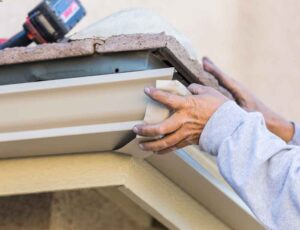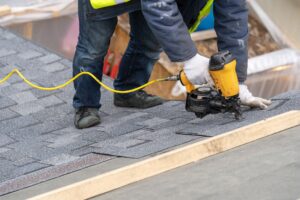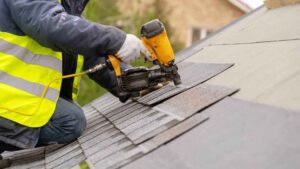As a home or business owner, your roof is your first line of defense against weather elements and unwanted visitors. Without your roof, your building wouldn’t be structurally sound. Thankfully, roofs can last many years with the proper care. Learn more about what you can do to maintain your roof with this preventative roof maintenance checklist.
What Is Roof Maintenance?
Roof maintenance periodically checks your roof’s vulnerable areas to address any problems. Most homeowners inspect their roofs and perform maintenance tasks seasonally. It’s also crucial to inspect your roof after major weather events. By taking the time to inspect and maintain your roof, you can address minor problems before they become significant and maximize the life span of your roof.
3-Step Roof Maintenance Checklist
The key to roof maintenance is to inspect your roof for any signs of damage. If you notice any damage, you must address it sooner rather than later. Our checklist will detail what you need to look out for. So, whether you’re a business or homeowner, you can benefit from this three-step roof maintenance checklist.
1. Check Inside Your Home or Business for Signs of Roof Damage
Before you go on the roof, you need to check inside for signs of water damage, such as mold, mildew, peeling paint, water stains, drips and leaks. If you notice any of these signs, you can try to pinpoint the cause when you inspect your roof. It’s crucial to keep in mind that leaks sometimes travel sideways, so the damage to your roof might not be directly above the water damage.
2. Inspect Your Roof
After you check the inside of your home, visually inspect your roof from the ground for missing shingles, slates, tiles or other damage. Only attempt to climb onto your roof if the conditions are safe — otherwise, call a professional roofing contractor to do the inspection for you.
Dirt and debris can pile up on your roof and clog drains or cause water build-up, leading to rot and decay. And tree limbs can damage roof materials as they fall on them.
Next, look over your roof’s surface for holes, tears, cracking and blistering. If you have a flat roof, there might be a low spot collecting water. Also, check for corrosion, loose, damaged or missing pieces or panels and fungus or moss.
If your roof has expansion joints, inspect them for cuts, tears or gaps. Also, check your flashings, if you have them, to see if they’re creating holes or pulling away from the roof.
Lastly, double-check any previously repaired or patched areas for signs of wear and tear or damage. You need to check that the previous issue was fixed and the repairs are still in good condition. These areas might need to be repaired again before you need to replace your roof.
3. Inspect the Structural Components
Roofs typically have a gutter system to direct water runoff to the ground. Inspect your drains for clogs by looking for dirt and debris, mold, watermarks, pooling water and moss. Also, look for deteriorated or damaged seals.
You must inspect the other exterior structural components, including chimneys, pipes, skylights and vents. Check for cleanliness and notate any signs of aging or damage, such as:
- Rust
- Fungus
- Rot
- Moss
- Peeling paint
- Sagging pipes
- Deflected hangers
- Bent elements
- Missing parts
- Pipe supports that put excess pressure on the roof membrane
- Cracked pipes
If your roof is on a commercial building, examine the crossovers, stairs, platforms and railings to ensure they’re structurally sound without any loose, damaged or missing parts, including damaged paint. Also, check that the safety signs are legible, clean and in the proper locations.
Seasonal Roof Maintenance Tips for Homeowners
As a homeowner, there are steps you can take each season to prevent roof damage and keep your roof clean. Check out these seasonal roofing tips for homeowners to keep their roofs in top shape.
Summer
Heat and rain are the biggest causes of roof damage in the summer. You can prevent weather-related damage by:
- Looking for holes or dents: When the summer heat is blazing, unwelcome creatures looking for a place to cool off might enter your home through small holes or dents in your roof. So, you’ll want to patch or block any holes or dents you see.
- Checking your roof for storm damage: You might experience summer storms that can damage your roof. Inspect it for missing shingles, slates, tiles and other storm-related damage.
- Inspecting your skylights: Skylights let the sunlight into your home, but if they aren’t sealed, rainwater can leak into your home.
- Ensuring your attic is adequately ventilated: The high summer temperatures provide optimal conditions for mold growth. One way to discourage mold growth is by ensuring your attic is properly ventilated so heat can escape and cool air can enter. Poor ventilation may also lead to premature failure of asphalt shingle roofing.
Fall
The biggest threat to your roof in the fall is dirt and debris. You can prevent debris and moisture damage by:
- Trimming trees: The cooler temperatures of fall, coupled with the dead leaves and branches, provides an opportune moment for trimming overhanging branches. Cutting them will reduce the amount of leaves that clog your gutters. Ideally, trim trees at least 3 feet back from the roof edge.
- Inspecting your chimney: If you have one, inspect it to ensure it’s functioning correctly, then check the flashings as these are common water entry points and can lead to brick degradation.
Winter
Snow is heavy and can cause water damage as it melts. Here are some ways to protect your roof during winter:
- Remove snow as soon as possible: Snow can pile up and cause significant roof damage or ice dams, so you need to remove it before it hardens. Ice dams are caused by fluctuating temperatures that cause the snow to melt and then re-freeze.
- Remove debris: Clear any debris as you notice it, especially in the gutters. Leaves cause blockages and are the main reason for ice dam formations.
- Check for sagging: You can walk around your home and inspect the roof from the ground after major storms to see if it’s sagging.
Spring
Just as you do a spring cleaning for your home, you should spring clean your roof. The pleasant temperatures and sunlight provide the perfect opportunity for you to:
- Clean your gutters: After winter, dirt and debris like leaves, sticks and acorns, accumulate in your gutters. Clearing out this debris allows water to drain properly and prevents water build-up and related damage.
- Inspect your roof material: Check your roof for any damaged, loose or missing materials.
- Check for mold or algae: Mold and algae damage your roof, causing leaks and other forms of deterioration. Spring is the perfect time to look for any because of all the moisture from snow and rain. If you notice any, don’t wait to get it removed.
Contact Cornett Roofing Systems for Your Roofing Needs
It’s always good to have a professional roof inspection annually, especially if you notice any signs of damage. Repairing your roof as needed is critical so it stays in good condition and you get the most out of your investment. Trust Cornett Roofing Systems with all your roof, inspection, repair or replacement needs.
Cornett Roofing Systems has more than 30 years of experience repairing and installing premium roofing materials. We’re experts at working with metal, slate, natural tile and copper roofing systems. Our high-quality repairs will have your roof functioning and working as well as new in no time. And our thorough inspections will bring any issues to your attention before they become bigger problems. Contact us today to schedule a free estimate.





